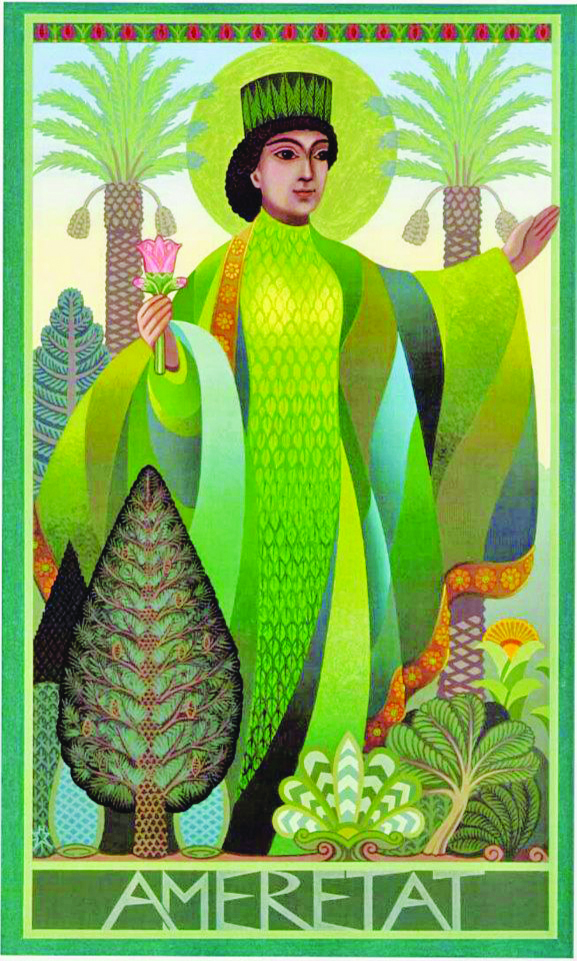 We are currently observing the month of Amardad as per the Shahanshahi calendar. Amardad (Avesta Ameretat) represents Ahura Mazda’s quality of eternity. Amardad is also the seventh Amesha Spenta (Bounteous Immortal) presiding over vegetation. Green vegetation and freshness go hand in hand. There is an expression in the English language about ‘keeping the memory (especially of a loved one) green.’ It means to keep memory fresh. When there is rain, there is greenery and, greenery makes everything look, feel, and smell fresh. Thus, Amardad represents immortality and eternity with freshness.
We are currently observing the month of Amardad as per the Shahanshahi calendar. Amardad (Avesta Ameretat) represents Ahura Mazda’s quality of eternity. Amardad is also the seventh Amesha Spenta (Bounteous Immortal) presiding over vegetation. Green vegetation and freshness go hand in hand. There is an expression in the English language about ‘keeping the memory (especially of a loved one) green.’ It means to keep memory fresh. When there is rain, there is greenery and, greenery makes everything look, feel, and smell fresh. Thus, Amardad represents immortality and eternity with freshness.
The Gatha (song) of Zarathushtra encapsulate eternal or timeless wisdom. However, despite its antiquity, the Gatha remain fresh for every generation and Zarathushtra’s thoughts and wisdom will remain eternal or ageless. It is the same with Cyrus the Great who is immortalised in human history through his great deeds. Thus, this month reminds us to live with such lofty thoughts, kind words and noble deeds that our life and life’s work is immortalised and remains green for generations to come.
Amardad is also a month dedicated to greening our planet. A devout Zoroastrian in ‘Homage unto Plants’ prays, “Nemo urvarayao vanghuyao Mazda-dhatayao ashaonyao” meaning “Homage (be) unto the good (and) holy plants created by Hormazd.” However, homage here should not be just the proverbial ‘lip service.’ It must be genuine, sincere, and actionable. We can all dream of a clean and green planet. However, unless we individually and collectively set a time frame to achieve this, it will remain a dream and not a goal to achieve. We need to have an actionable plan. What are the plastic items we are ready to do away with? Are we going to grow some plants at home? Are we going to walk more and minimise use of vehicles. Are we going to take recycling waste seriously?
We cannot completely do away with use or plastic or petrol. However, we can at least minimise or control its use. We can always argue, whether “my changing will really help?” The answer is, we need to be the change we want to see in this world. What we practise, our family and friends will observe and perhaps take the cue and even if they do not, we can have the satisfaction of knowing that we are trying to do our tiny little bit.
Article 51A(g) of the Indian Constitution envisages the fundamental duty of a citizen, “to protect and improve natural environment, especially trees.” In 1993, in his keynote address at Chicago’s World Religious Conference, the Dalai Lama warned, “Destroying trees is a dangerous game we are playing.” Currently, around forty per cent of all commercial trees felled worldwide are to satisfy demand for paper (source: WWF). However, each time paper is recycled, environmental saving is ensured since it takes less energy to produce paper from waste paper than it does from wood which also means less carbon dioxide is produced in the manufacturing process and less methane is produced from the paper breaking down in landfills.
It takes less water to break down waste paper than it does to break down wood. If paper recycling is used to the full potential, wood is only needed once to produce five cycles of paper which also means saving waste from landfill five times. Also, it only takes 1.2 tonnes of waste paper to produce one tonne of recycled paper whereas it takes 2.5 tonnes of wood to produce one tonne of virgin fibre paper.
In Theosophy, it is believed that trees radiate universal life, light, and love. The whole world is inter-connected and what pervades the entire Universe is ONE – a single Consciousness. Quantum physics also appears to support this theory!
The Holy Bible (Corinthians) say, “Trees belong to the Lord in all their glory.” The Upanishad say, “Sarvan khalu dam Brahma” or “Everything existing in the Universe has God-consciousness.” The ‘Rig Veda,’ ‘Yajur Veda’ and ‘Atharva Veda’ seek the blessings of trees, especially the Bilva, Neem, Banyan, Arasu and Audambar. The tenth Canto of Narayaneenam, the first shloka says, “God created trees.”
Of course, trees have always had a place of honour in Indian mythology and folklore. From the little Tulsi to the giant Banyan, most trees used to be conserved with devotion and love, until unscrupulous contractors and timber thieves were given a free run of the country.
The wood of the apple tree is believed to be the favourite of Shiva. Tribal people worship the Karam tree. Great men are often compared with the Banyan which gives shelter and shadow to the traveller. Incidentally Gautam Buddha gained Nirvana under the Bodhi tree.
At Alandi and Nerur in Maharashtra, it is believed that Sant Gnyaneshwar and Sadashiva Brahmendra bless devotees through trees. The sacred river Narmada has her origins at Amarkantak in the roots of a sacred tree. In Kalidasa’s ‘Abhigyan Shakuntala,’ Shakuntala says farewell to every tree in the ashram before leaving for Dushyant’s palace.
In England, there are many sacred old trees. The individual spirits of trees were worshipped by the Druid priests of ancient Europe. Trees were regarded by these ancients as “residences of the earth spirit.” They also believed that the earth spirit finds its receptacle / residence in springs, wells, rivers, rocks, and caverns.
Trees in Zoroastrian tradition
Iranian Zoroastrians consider several Cypress trees in Iran to be holy and worthy of reverence. For example, at Abr-koh near Yazd, in Iran, there is a 4,500 – 5,000-year-old Cypress tree. In the courtyard of the Atash Kadeh in the village of Cham (Yazd), there is another Cypress tree said to be about 1,500 years old.
At Sanjan in India there is the ‘chalto ambo’ or the ‘walking mango tree.’ This tree has reportedly moved about two hundred metres from its original place in more than two centuries and is continuing its ‘walk.’ How does this tree walk? Curiously the tree’s branches grow parallel to the ground from the main stem. Roots develop from a part of the branch that touches the ground, which develops in the form of a stem and the original stem then dries off. The branch keeps on growing parallel to the ground from the new stem and new roots appear in the same pattern. This process has continued for several hundred years and villagers claim that this is the way the tree walks.
Data collected by forest officials and tales handed down through generations of villagers indicate that the mango tree may have been planted by early Parsi settlers over a thousand years ago.
As Zoroastrians we have been taught to revere all good creations of Ahura Mazda. How then can we allow destruction of what we revere? Planet earth on which life exists, is resilient and has been around for over four and half billion years. This planet is not dependent on us humans. Rather it is us who are dependent on earth and its limited resources, which we are recklessly depleting without replenishing.
Remember, the earth does not need us… and that’s why we need to care about it even more!
- Why Pray In A Language We Do Not Understand? - 29 March2025
- Celebrate Nature’s New Year With Purity And Piety of Ava - 22 March2025
- Celebrate Navruz 2025 With The Spirit Of Excellence And Wholesomeness - 15 March2025
